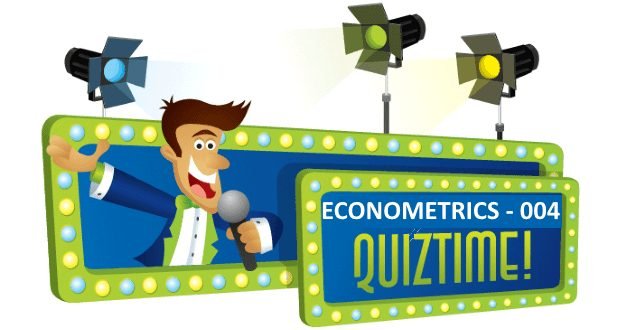500 câu trắc nghiệm Kinh tế lượng – 12A

Tổng hợp 500 câu trắc nghiệm + tự luận Kinh tế lượng (Elementary Statistics). Tất cả các câu hỏi trắc nghiệm + tự luận đều có đáp án. Nội dung được khái quát trong 13 phần, mỗi phần gồm 3 bài kiểm tra (A, B, C). Các câu hỏi trắc nghiệm + tự luận bám rất sát chương trình kinh tế lượng, đặc biệt là phần thống kê, rất phù hợp cho các bạn củng cố và mở rộng các kiến thức về Kinh tế lượng. Các câu hỏi trắc nghiệm + tự luận của phần 12A bao gồm:
SHORT ANSWER. Write the word or phrase that best completes each statement or answers the question. Provide an appropriate response.
1) Describe the runs test for randomness. What types of hypotheses is it used to test? Does the runs test measure frequency? What is the underlying concept?
The runs test for randomness is a procedure for testing the randomness of data (with only two characteristics) using the concepts of runs. A run is a sequence of data that exhibit the same characteristic. For example, the data set M M M M M F F F M M F F F F has four runs. The null hypothesis is that the sequence is random and the alternate hypothesis is that the sequence is not random. The runs test is based only on the order in which the data occur; it does not test the frequency of the data. The underlying concept is that if the number of runs is very low or very high, randomness is lacking.
2) Describe the Wilcoxon signed-ranks test. What types of hypotheses is it used to test? What assumptions are made for this test?
The Wilcoxon signed-ranks test is similar to the sign test, but it looks at the magnitude as well as the signs of the differences, and thus has a higher efficiency level than the signs test. The test is used to test claims about differences between two dependent (paired) samples. The Wilcoxon signed-ranks test assumes that the population of the differences (found from the pairs of data) has a distribution that is approximately symmetric and that the pairs have been randomly selected.
Use the sign test to test the indicated claim.
3) A standard aptitude test is given to several randomly selected programmers, and the scores are given below for the mathematics and verbal portions of the test. Use the sign test to test the claim that programmers do better on the mathematics portion of the test. Use a 0.05 level of significance.
| Mathematics | 347 | 440 | 327 | 456 | 427 | 349 | 377 | 398 | 425 |
| Verbal | 285 | 378 | 243 | 371 | 340 | 271 | 294 | 322 | 385 |
H0: The math scores are equal to or less than the verbal scores.
H1: The math scores are greater than the verbal scores.
Test statistic: x = 0. Critical value: x = 1.
Reject the null hypothesis. There is sufficient evidence to support the claim that the math scores are greater than the verbal scores.
4) A researcher wishes to study whether a particular diet is effective in helping people to lose weight. 92 randomly selected adults were weighed before starting the diet and again after following the diet for one month. 50 people lost weight, 40 gained weight, and 2 observed no change in their weight. At the 0.01 significance level, test the claim that the diet is effective.
Use the Wilcoxon signed-ranks test to test the claim that both samples come from populations having the same distribution.
H0: the diet is not effective. H1: the diet is effective.
Convert x = 40 to the test statistic z = -0.95. Critical value: z = -2.33.
Fail to reject the null hypothesis. There is not sufficient evidence to support the claim that the diet is effective.
5)11 runners are timed at the 100-meter dash and are timed again one month later after following a new training program. The times (in seconds) are shown in the table. Use a significance level of 0.05 to test the claim that the training has no effect on the times.
| Before | 12.1 | 12.4 | 11.7 | 11.5 | 11.0 | 11.8 | 12.3 | 10.8 | 12.6 | 12.7 | 10.7 |
| After | 11.9 | 12.4 | 11.8 | 11.4 | 11.2 | 11.5 | 12.0 | 10.9 | 12.0 | 12.2 | 11.1 |
Test statistic T = 16.5. Critical value: T = 8.
Fail to reject the null hypothesis that both samples come from the same population distribution.
Use the Wilcoxon rank-sum test to test the claim that the two independent samples come from the same distribution.
6) A teacher uses two different CAI programs to remediate students. Results for each group on a standardized test are listed in a table below. At the 0.05 level of significance, test the hypothesis that the two programs produce different results.
| Program I | Program II |
| 60 75 61 63 | 66 89 68 77 |
| 86 69 64 70 | 84 80 81 87 |
| 72 82 59 | 78 73 91 93 |
| 94 95 |
\({\mu _R}\) = 143, \({\sigma _R}\) = 18.2665, R = 90.
Test statistic: z = -2.90. Critical values z = ±1.96.
Reject the null hypothesis. There is sufficient evidence to support the hypothesis that the two programs produce different results.